Hello! My name is Casey, and today we are discussing the Goldendoodle!
Goldendoodles are one of the most popular cross-bred pups around, followed by Labradoodles and Puggles.
As a former veterinary technician of over 7 years, I have had the pleasure of meeting and treating many different doodles and mixed breed pups.
I have been graced with the opportunity to speak with several breeders and meet their puppies as well!
Goldendoodles are one of my top favorites, and the most common question I have gotten about these adorable pups over the years is how they shed their puppy coat.
So in this article, we are going to take a closer look at the Goldendoodle breed and what affects their coat type.
What Is A Goldendoodle?
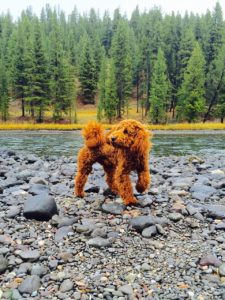 The first topic to look at is what exactly is a Goldendoodle? Well, it’s a cross between a golden retriever and a poodle!
The first topic to look at is what exactly is a Goldendoodle? Well, it’s a cross between a golden retriever and a poodle!
The size of the poodle doesn’t precisely matter, it can be a miniature poodle or a standard one.
When it comes to professionally breeding dogs, artificial insemination is not unheard of and is often a common practice to ensure desired traits get passed down.
However, when it comes to crossbreeding two very different types of dogs, the traits that are passed down can vary.
Goldendoodle Generation Review
Goldendoodle generations are referred to as the following:
- F1
- F1B
- F2
- F2B
src=”https://officiallypets.com/wp-content/uploads/2019/02/goldendoodle-164935_1280-1-300×268.jpg” alt=”white bouncing dog” width=”209″ height=”187″ />An F1 generation is a 50-50 cross between a purebred Poodle and a purebred Golden Retriever.
This is followed by an F1B doodle pup, which is the result of a purebred Poodle that has been bread with an F1 doodle.
The F2 generation is similar to their 50-50 parents however are the mixed doodles instead, so an F2 puppies parents are both 50-50 Goldendoodles.
Similarly, for an F2B doodle puppy, this one’s parents consist of an F1 50-50 cross doodle being bread with F1B doodle who’s parents are a poodle and doodle.
These variations in generation breeding will greatly affect a doodles coat type, along with a more guaranteed consistency of traits.
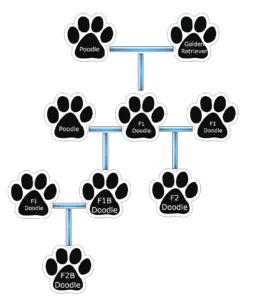
How Big Are Goldendoodles?
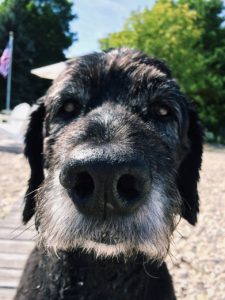 Poodle sizes come in teacup, miniature, and standard. Each size is determined by both height and weight in the poodle world.
Poodle sizes come in teacup, miniature, and standard. Each size is determined by both height and weight in the poodle world.
Much like the poodle, Goldendoodles can come in three sizes. However, due to the average size of golden retrievers, the average weights are going to be slightly different for the doodle offspring!
For Goldendoodles you can expect the average of miniatures to weigh around 15 to 30 pounds, mediums to weigh 30 to 45 pounds, and standards to weigh 45 to over 100 pounds.
Since all the different sized poodles are the same exact breed, when it comes to purchasing a Goldendoodle puppy, there is no guarantee that you will get the size you want, regardless of the parent’s sizes.
What Makes A Dog “Hypoallergenic?”
I hate to break it to you, but referring to a dog as hypoallergenic is a very misleading statement.
You see, those with dog allergies are not actually allergic to the fur or hair, but according to The American College of Allergy, Asthma, and Immunology, those with allergies tend to be affected by a dog’s dander
This is something that all animals and people shed naturally, saliva, and urine.
That being said, some individuals with dog allergies are able to tolerate some breeds over others.
Breeds such as poodles, bichon frise, and the schnauzer are just three examples of breeds considered ‘hypoallergenic.’
The one factor that “hypoallergenic” dogs have in common, is they typically don’t shed nearly as much nor as noticeably as other dog breeds.
This makes the mixed breed of the Goldendoodle a popular option for those wanting to enjoy having a pooch companion without the allergic reactions!
If you’d like to read more about the best non-shedding small dog breeds, take a look here.
What Are The 3 Goldendoodle Coat Types?
Since the Goldendoodle is a mix of two different breeds of dog with two very different coat types, it’s no wonder that there are some variations!
The first type is the loose and wavy, which is the most common type of coat found in a Goldendoodles. These coat types are considered low to non-shedding types.
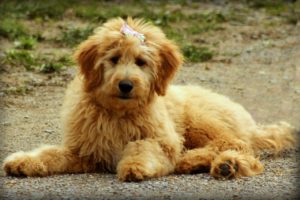
They are easy to maintain with at home brushings needing to be focused on the high-friction areas including behind the ears, hindquarters, and underarms with body brushing required perhaps once per week.
The second coat type is the straight fur that is typically seen on the Golden Retriever side.
These coats are considered flat or sporty and are the easiest to maintain with minimal brushing. There are no waves or crimping and do have some light shedding.
The third and final coat type is curly. These coats are easily identified by crimping fur on the forehead of the pups and are the most common in F1B litters which are 75% poodle and 25% Golden Retriever.
If you need help grooming you Goldendoodle yourself check it out here!
When do Goldendoodles Shed Their Puppy Coat?
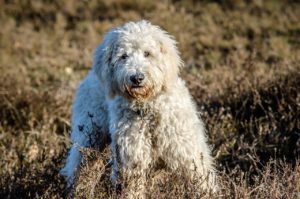 All puppies are born with a single coat layer, even the double-coated breeds and Goldendoodles are no different. The typical age of shedding is between 5 to 8 months of age.
All puppies are born with a single coat layer, even the double-coated breeds and Goldendoodles are no different. The typical age of shedding is between 5 to 8 months of age.
Typically when puppies get their adult coats, the adult versions are stiffer and thicker, this is especially true for Goldendoodles.
Given the mix in breeds, coat quality will widely vary from one dog to the next and you won’t know the full quality until after your pup’s adult coat is fully in.
Your experience may vary from others, however, in general, your pup’s coat may have some shedding, easier matting, and the base of your pup’s coat will begin stiffening up and become less fine.
When looking at Goldendoodle pups, speak more with the breeder to find out more about the generation of pup you’re taking and what you should expect during the coat transition period.
Final Thoughts
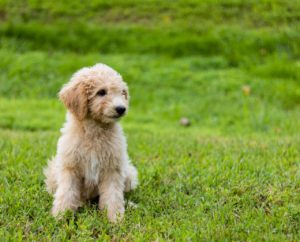 Goldendoodles are fantastic dogs that vary in size, shape, coat type, and color.
Goldendoodles are fantastic dogs that vary in size, shape, coat type, and color.
A good breeder will be able to tell you everything you need to know about your new doodle puppies pedigree and all the care tips you will need to provide for it.
You’ve taken the first steps in learning more about your puppy to be and this is great!
Just remember that given the mixed traits, and despite selective breeding, Mother Nature tends to do as she wishes so there is no guarantee you will get exactly what you’re expecting in your pup!
If you’re looking for more information about Goldendoodle shedding, check out the article below:
Do Goldendoodles Shed? – Goldendoodle Shedding Guide!

